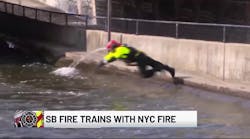As you proceed in operations at the scene of a building collapse, one of the resources you will need to use is heavy equipment. Bobcats, front-end loaders, dump trucks, and even large cranes are of great value to the incident commander and/or the operations chief. Use of heavy equipment usually comes into the last two stages of collapse rescue operations.
There are five different stages of collapse rescue operations:
1. Survey the area for victims: This is where quick, overall surveys of the area of collapse are done. See previous article on recon teams.2. Light and surface rescue: These victims are typically located in the first several moments of a response. They are easily seen and, in most cases, removed from the site with little effort from the first responders.
3. Void exploration: After the surface victims are removed, some further exploration into obvious, visible, voids should be done. This effort should include enough personnel and equipment to affect basic rescues and should also have a stand-by (RIT) team before any entry is done. A key point here is to ensure hazardous materials specialists perform basic atmospheric monitoring prior to entering the void. That void is technically a confined space and should be treated as such.
4. Specific Debris Removal: This is where trapped victims need only one portion of a slab or building component lifted for removal. This is accomplished through air bags, hydraulic rescue tools, or perhaps a crane with proper rigging.
5. General Debris Removal: This is when the entire building is "delayered" from the top down with heavy equipment. Removing slabs and debris with proper rigging. When voids are uncovered, don't forget to let the search team (and haz-mat) explore the void for possible victims.
When considering the use of heavy equipment, be sure you get a structural engineer to give advice on just where and in what fashion you should use the equipment. They are the best qualified and can give you great advice on exactly where and in what fashion to do the "picks".
Use of cranes involves more than just clearing an area for them. The larger (80-120 ton) cranes take a large area to set up and usually come to the scene on several flatbed trucks. They have to be assembled and can take an hour or more to make ready for use. Smaller, all-terrain, cranes can be set up quicker and are more maneuverable than their larger cousins and should be considered when possible. Some calculations of the weight of the material to be moved will help you decide what crane to use. Keep in mind that the farther away from the pick, the less the crane can lift. The load ratings for cranes are set on them being able to operate with as little boom out as possible. In other words, the closer to the pick, the more they can lift. If you have a 100-ton crane, but it has to boom out 45 or 50 feet, it may only be able to lift 40-50 tons.
Rigging the material for the pick is another critical task. Use of slings, weather they are cable or webbing, have to be rigged correctly in order to remain as safe as possible. Eyebolts can also be mounted into the slabs for ease of rigging. There are courses that teach specific lifting and rigging techniques that departments should consider conducting in order to make the picks safer and more efficient. These courses also cover hand signals that allow the rescue personnel to operate in sync with the crane operator.
Safety Considerations:
When operating around cranes, or any heavy equipment, additional safety measures need to be taken. These things can be written into the safety plan, or can be specific to the task at hand. Either way, safety is never as important as when operating around heavy equipment. Additional considerations should include:
- Additional lookouts, personnel on the perimeter only focusing on the picks.
- Specific identification for the person making the hand signals to the operator. It could as simple as a different color helmet or an armband, the important thing is that the equipment operator can easily identify the person calling the shots.
- Clearly identify, and make known to all, escape routes for personnel operating around the picks.
- Make sure the personnel operating on the site are aware of the evacuation signal.
- Have heavy rigging specialists, either trained US&R personnel or qualified riggers check the slings and/or webbing used for the pick for proper center of gravity.
- Make sure all personnel are removed from the area where the pick will swing overhead. Tons of material can release at any moment, showering rescue personnel with concrete and steel that your basic helmet won't stop.
Perhaps the most important issue with heavy equipment is having qualified operators. Some departments are fortunate to have personnel who operate heavy equipment as a side job and they can be used as needed. Most firefighters will claim to be able to operate any type equipment, regardless of what size it is. Using equipment from rental companies can be more cost-efficient, but they come at the cost of no operators.
And it has been my experience that firefighters are not for finish work. They can destroy and break almost anything, but if you need finish work, especially with heavy equipment, make sure you have a qualified operator!







